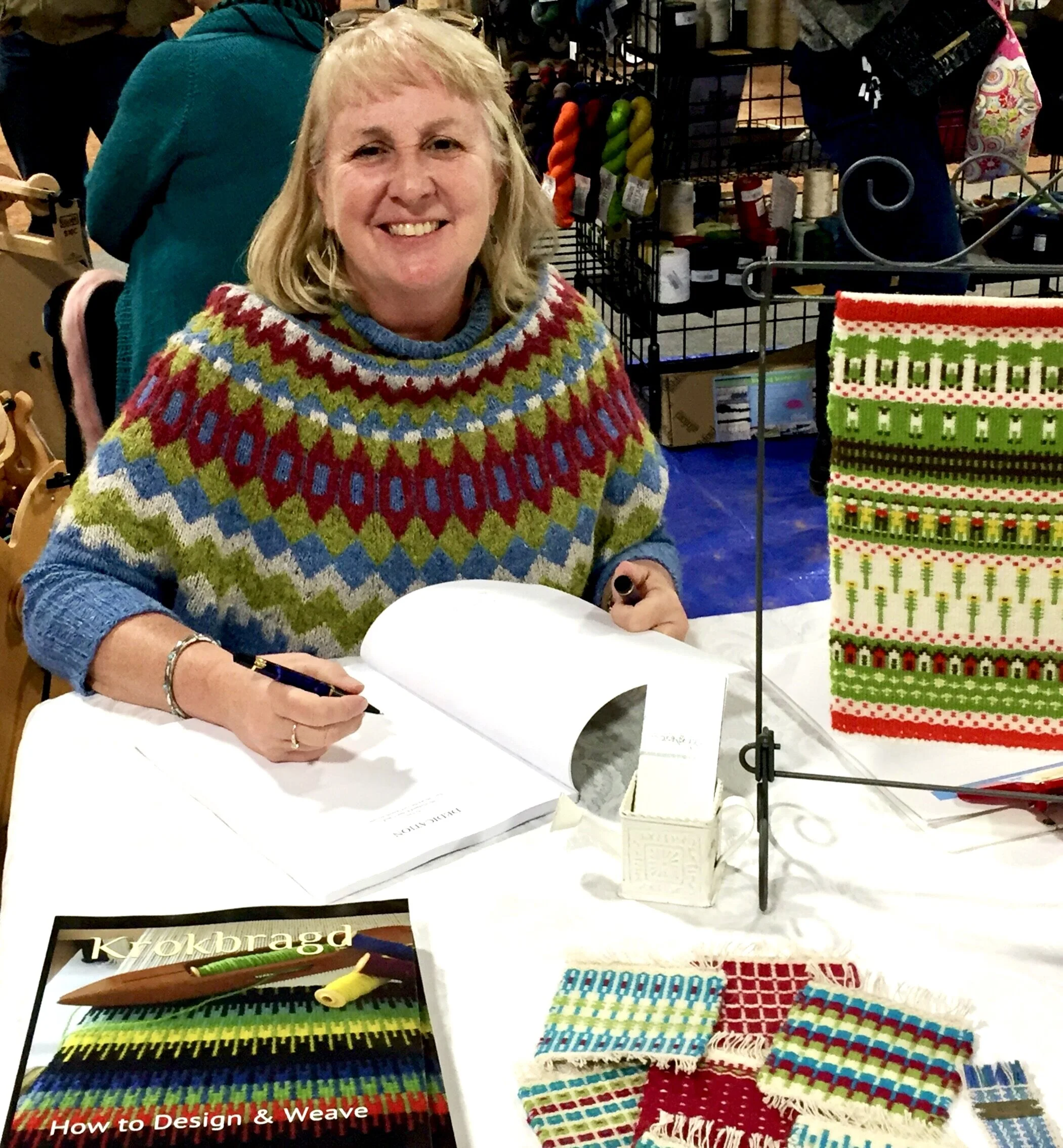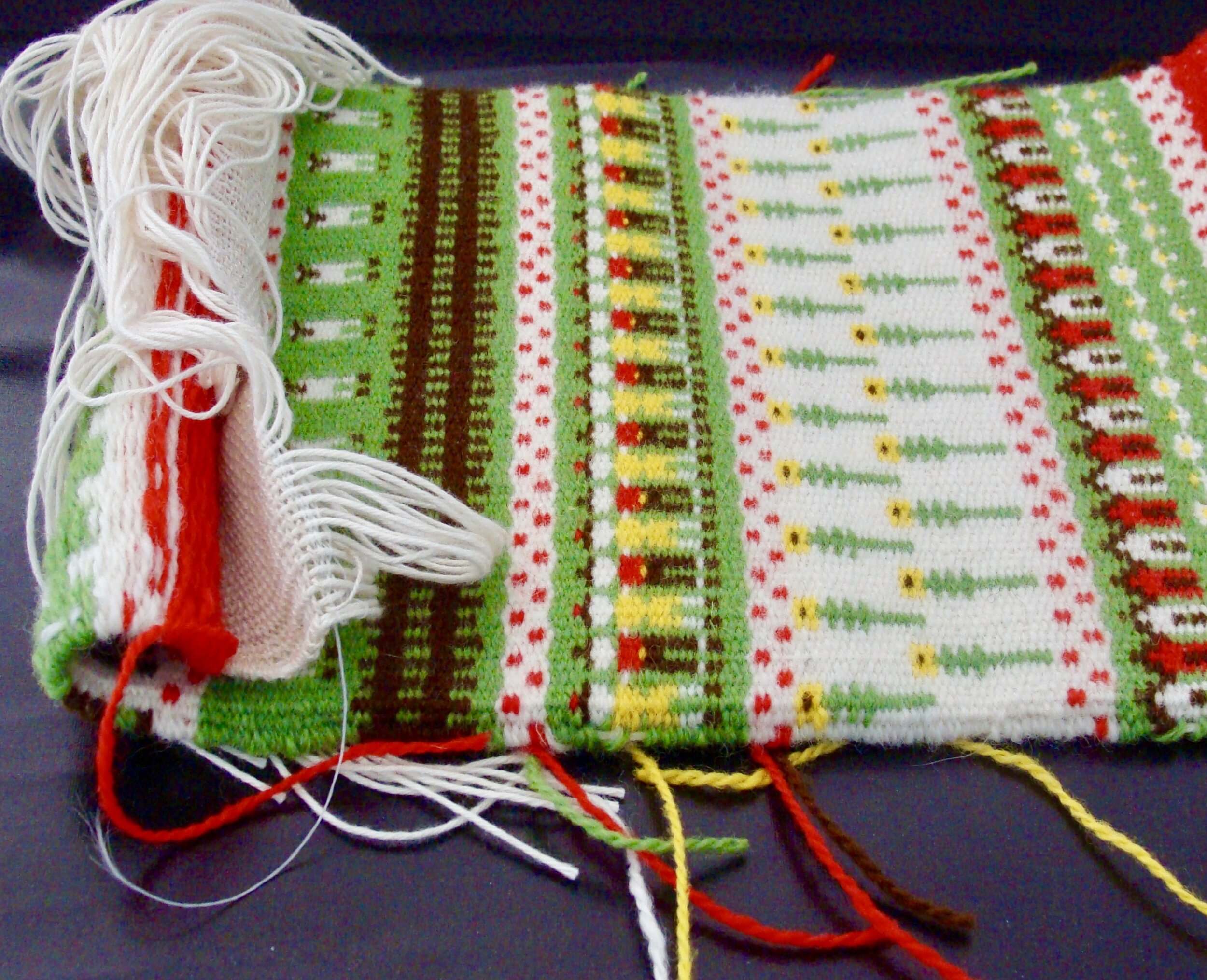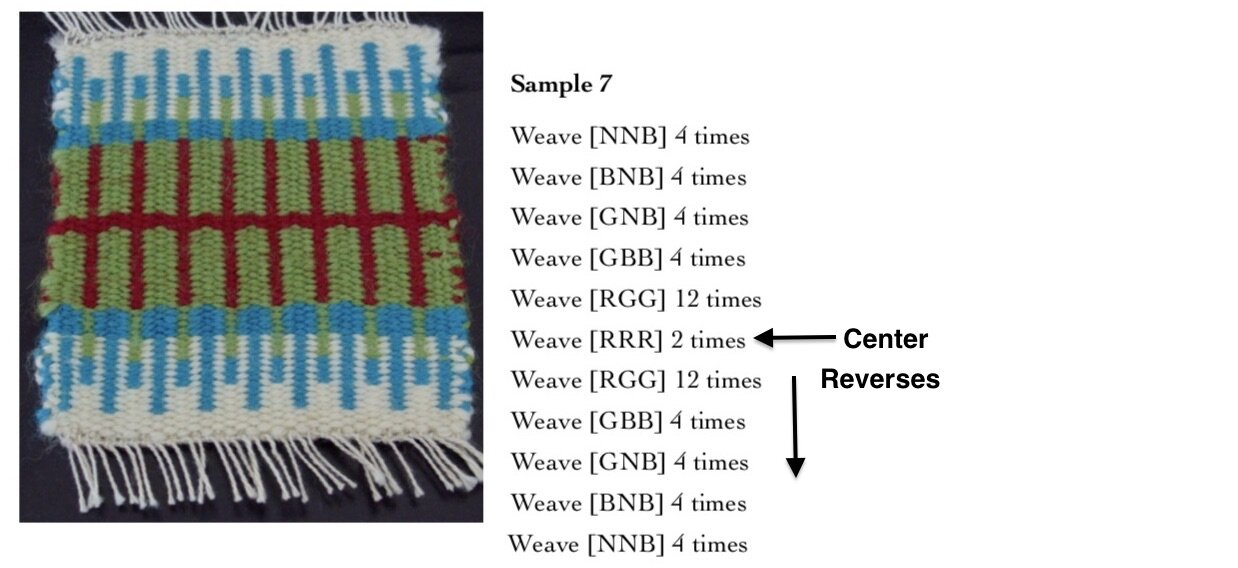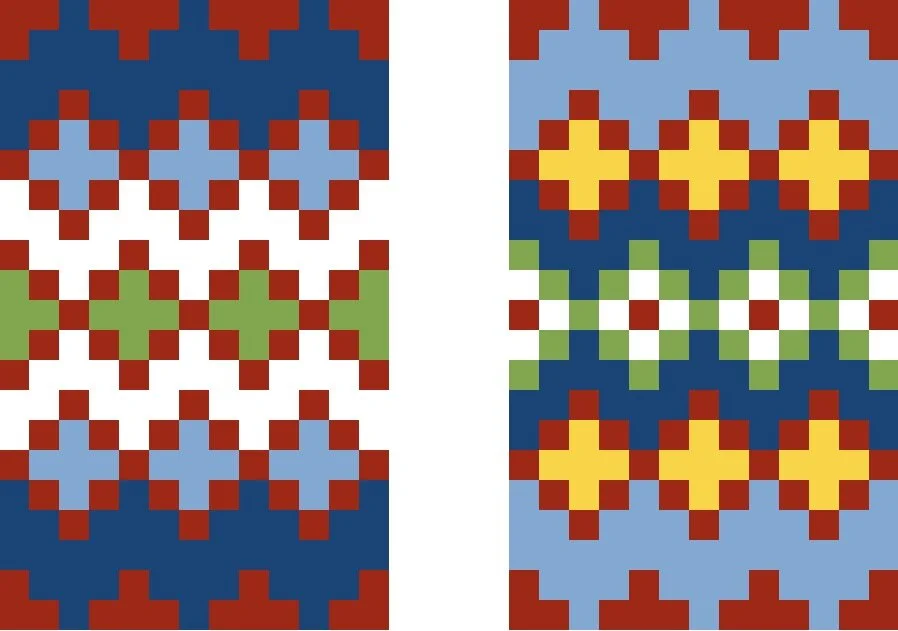Krokbragd Q & A
It is such a pleasure to hear from you either through leaving a comment on a post or contacting me. These interactions allow for a bit of personalizing in the vastness of cyber land. Some of your emails have included questions. While I have responded individually, I thought the information might be beneficial to other readers so I gathered your krokbragd questions and my responses into this one post.
Q - I am struggling with having the ends of my pieces curling up toward the right side when taken off of the loom. Wet pressing and different finishing of the warp ends have not helped the situation. I am hoping that you can make a suggestion to help me so that I can stop this from happening.
In the photo above you can see how curled my piece’s end was when I first took it off the loom. The densely packed wefts in krokbragd, or really any weft-faced weaving, tend to make the fabric curl. A hard steam press will both flatten the fabric as well as meld the warp and weft threads into each other.
Here’s how I do it. With the wrong (or back) side up, cover the fabric with a wet cloth. I use a dampened cotton handkerchief on smaller projects and for heavier projects, like rugs, I use a damp bath towel. Using a lot of pressure and a hot iron, place the iron on the cloth until steam rises. I really press hard and keep my iron in place say for a count of 10 (one one thousand, two one thousand, three one thousand, etc.). Lift the iron into the next position; do not slide the iron across the fabric. Wet the cloth or towel again and steam once or twice more.
Q - For your rug you used double warp ends. Do you thread both through a single heddle or do you separate them and thread each warp end separately through different heddles?
I threaded two warp ends per heddle as well as sleyed two ends in each dent in the reed.. My thought was that as this was a substantial piece, I reasoned doubling the warp ends would improve the strength and integrity of the finished rug.
Q - Do you get your rug yarn from Halcyon Yarns in Maine or do you have another source?
Yes, I purchased my rug yarn from Halcyon Yarns in Maine. I used the Halcyon Classic Rug Wool; a 3-ply 100% wool yarn. There are nearly 100 color choices and you can use Halcyon’s online color mixer to help make your color palette decisions.
Vävstuga is another quality online shop that sells rug yarn. In particular, their Borg’s 1.25/1 Mattgarn is a heavy single-ply wool yarn for weft-faced rugs. I have not woven with their rug yarn, but I have been very pleased with their Tuna & Faro wool yarns for other krokbragd and weft-faced projects.
Rauma Ryegarn (1.5/2) is 100% Spælsau Wool for rug weaving. I recently became a retailer for this yarn as well as other Rauma yarns. If you are interested in purchasing, you can contact me.
Q - I am warping my Rigid Heddle loom with two 10-dent reeds. To thread the holes and slots from Heddle II to Heddle I, I assume I pull the thread on Heddle II back out toward the back, thread it through the hole and then through the next slot on Heddle I. It’s hard as there is maybe 2 inches between reeds.
You are absolutely correct on your description of the two heddle threading process; pulling the thread back out, etc. It is a little fiddly with the limited space in between the two heddles. You might try threading the Heddle II hole without using a sley hook as the hole on a 10-dent reed is decent size and you likely can thread fairly easy without a hook. Since it’s going through a slot on Heddle I, that’s a little easier. The other thing you might try is placing Heddle II in the up position and Heddle I in neutral or the down position to stagger them and create a little more room. Of course when you are ready to tie onto the front beam place them both back into the neutral position.
Q - The picture on your Krokbragd book enticed me to buy it and finally use my rigid heddle loom. I've been doing only tapestry weaving for a few years. Could you direct me to somewhere that can explain design drafts? I guess my first question is "What is a shaft?" Is it somehow different from a shed?
And then the drafts - the lower left section with the squares shows the actual pattern, the section to the right of that shows the sheds and the colors for each shed, and the section on top left shows what the wefts actually look like in each shed. What does the upper right section mean???
With your background in tapestry weaving, I certainly can see where the use of the term shafts wouldn’t make much sense. The shed is the space created between the upper and lower warp threads and through which the weft thread passes. On a rigid heddle loom the sheds are created by raising or lowering the rigid heddle to create the possibility of two sheds. By using pick-up sticks or heddle rods, additional sheds can be made. On a floor or table loom, sheds are created by shafts that raise or lower the warp threads. You may have heard the terms 4 shaft or 8 shaft looms.
On the draft, the box you are referring to in the upper right section is the tie-up. The section with the squares showing the pattern is called the drawdown. The left section along the top is the threading for the warp threads. The section down the right side is the treadling order for each of the weft picks.
A book I highly recommend to learn weaving on a shaft loom is Deborah Chandler’s Learning to Weave. It is a classic book that many weavers, myself included, have found invaluable.
Here’s a link on the Weaver’s Craft website on ‘How to Read a Weaving Draft’ .
Finally, Kelly Casanova has excellent information in her online Weaving Lessons.
Q - I am looking for tips to help with my current weaving as it is dipping in the middle. I think I might need to use a temple on my rigid heddle loom even though my weaving is only 16 inches. Any tips would be greatly appreciated as the patterns are so lovely to see but I'm worried that the curves won't even out when it's off the loom.
Angling the Weft
Bubbling the Weft
A couple thoughts to resolve your “dipping”. It sounds like a tension issue, in other words the warp threads in the middle have a looser tension than the selvedge threads. Weft-faced weaves such as krokbragd have a tendency for the selvedge edges to draw in and thus create a different tension between the edges and the middle. To prevent draw-in, the weft needs to be slack enough to curve over and under the warp without pulling in the edges. If the weaving width is relatively narrow, say less than 15 inches, angling the weft in the shed at a 45-degree angle should be sufficient. On wider pieces, bubbling the weft works better. The weft pick is pulled into an arc about six inches from the fell at its center and then “bubbled” by pulling the weft down at intervals across the width of weaving. A temple is sometimes used to further aid in preventing draw-in.
As you weave, continue to check that the fell line is even all the way across as you beat each pick. If you start to see curving of the fell line, take action then to correct the issue so it doesn’t worsen as you continue to weave.
Another solution may be to weight the looser warp threads to adjust their tension. Hanging small weights on those pesky threads will tighten them up. A simple way would be to hang S-hooks (from the hardware store) on the threads. I actually use little weights with a hook meant to hold down helium balloons. I bought them very cheap at the craft store. Be creative here. You can also try shoving a pick up stick or flat shuttle under the loose threads at the back of the loom near the back beam, this provides a little additional tension.
Q - I want to make a 10'“ x 10” pillow with a krokbragd pattern that goes all the way around the pillow and overlaps 4" on the back. The pattern will extend all the way to the side seams. I will be using my 7.5 heddle and Lily Sugar and Cream cotton yarn. My pattern will be two repeats of the last pattern of your pillow and your center section and then a reverse of the last pattern repeated. My warp will be 11 1/2" x 24 (plus waste etc.). My problem is: how do I know if my pattern is going to be long enough to make the 24" needed to cover the pillow?
The best way to address this is to figure what your picks per inch will be for the yarn you will be using. I’ve not woven krokbragd with Lily Sugar and Cream so I can’t answer that for you. However to determine that information, you could weave several inches of sample and then count how many picks there are per inch, remembering that three picks make one row in krokbragd. Let’s just say you get 18 picks/inch for the weft to pack nicely. That would be six rows of pattern per inch. You could then determine you need 120 rows of pattern for your pillows (6 rows/inch x 20 inches = 120 rows). This does not count your headers on either end. This will give you a good place to start.
Q - I have been fascinated by boundweave and now krokbragd, but have never been able to get my head around it. To me, it's similar to overshot in that it builds up shapes by repeated shots, but without the tie down shot, so I can't figure out how it works. How does it hold itself together?
Krokbragd is a weft-faced fabric, very dense and sturdy, so it doesn’t need a pick of tabby between the pattern picks.
Q - I heard there is an Errata sheet for the book. Where do I find it?
Photo from Unsplash - @Caleb Wood
Despite reading and rereading my drafts multiple times, there are unfortunately a few errors in the pattern drafts. Phewy!!!!
Both the e-book and the print book were updated as of May 14, 2019. If you purchased either the e-book or the print book after this date, you have the updated version. Just to double check, on the copyright page (print version) the third line should say ‘First Revised Edition’.
If you purchased the e-book prior to May 14, 2019, you can download the updated version of the e-book from the Manage Your Content and Devices page on Amazon.com.
If you purchased the print book prior to May 14, 2019, you can download a PDF containing the Errata corrections from the links below.
Errata PDF (single sheet) here
or individual sheets for Page 81 here, page 82 here, page 83 here
Q - if I want to mirror a pattern at the mid point, do I just work the steps in reverse order?
Yes, if you want to mirror your pattern, just reverse.
Q - I am trying to find where to purchase your book wholesale for my shop.
The wholesale pricing is dependent on the number of books ordered. For example, a quantity of 20 books is $16.50 per book which includes shipping to you. The book retails for $24.99. I invoice through PayPal. If you are interested in a wholesale order, please contact me.
Q - Your book has great info on the technique and history of krokbragd but I was really looking for a book of patterns.
I hear you (and others)! Look for ‘Krokbragd Patterns’ coming Spring 2021.






















